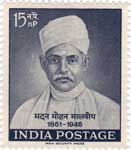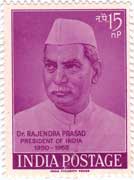Themes & Thoughts of the day : December
| 25 December : Madan Mohan Malaviya’s Birth Anniversary | ||
“Patriotism needs it, humanity dictates it, and every possible consideration that you can have will enforce the carrying out of the Swadeshi Movement in the most earnest spirit, not only now but for a long time to come..... Help the Swadeshi cause so that you may enable the poor people of all parts of India to find food and clothing for themselves.” - Madan Mohan Malaviya at Surat Swadeshi Conference in 1907. Madan Mohan Malaviya (b. December 25, 1861, d. November 12, 1946) was an educationist and politician notable for his role in the Indian independence movement and his espousal of Hindu nationalism. He was respectfully addressed as Pandit Madan Mohan Malaviya and also addressed as 'Mahamana'. Madan Mohan Malaviya is most remembered as the founder of Banaras Hindu University (BHU) at Varanasi in 1916, the largest residential university in Asia and one of the largest in the world. Malaviyaji was Vice Chancellor of Banaras Hindu University from 1919–1938. Malaviyaji was the President of the Indian National Congress on four occasions (1909 & 1913, 1919, 1932) and also one of the initial leaders of the Hindu Mahasabha. H e left congress in 1934. Malviya was one of the founders of Scouting in India. He also founded a highly influential, English-newspaper, The Leader published from Allahabad in 1909. He was also the Chairman of Hindustan Times from 1924 to 1946. His efforts resulted in the launch of its Hindi edition in 1936. Malaviyaji was posthumously conferred with Bharat Ratna, India's highest civilian award, on 24th December 2014, a day before his 153rd Birth Anniversary. |
||
| 16 December : Vijay Diwas (Victory Day) | ||
“No Sir, I will not abandon my tank. My gun is still working and I will get these bastards.” - Second Lieutenant Arun Khetarpal, PVC over the radio to a superior officer who had ordered him to abandon his burning tank during 1971 Indo Pak War. He died on 16th December in the Battle of Basantar during the Indo-Pakistan War of 1971. Vijay Diwas (Victory Day) is commemorated on every 16th December in India as it marks its military victory over Pakistan in 1971 during the Indo-Pakistani War of 1971, who were alliance of Bangladesh Mukti Bahini. The end of the war also resulted in the unilateral and unconditional surrender of the Pakistan Army and subsequent secession of East Pakistan into Bangladesh. On this day in 1971, the chief of the Pakistani forces, General Amir Abdullah Khan Niazi, along with 93,000 troops, surrendered to the allied forces consists of Indian Army and Mukti Bahini, led by General Jagjit Singh Aurora, of India in the Ramna Race Course, now Suhrawardy Udyan, in Dhaka after their defeat in the war. Victory of India in 1971 war was a great feat performed by the Indian Army. The anniversary of Vijay Divas is observed across India by paying tributes to the martyrs who laid down their lives for the nation. |
||
| 03 December : Dr. Rajendra Prasad's birth anniversary | ||
“My living too has been of such a simple nature that I do not require any special equipment of comfort. The wealthier you become the more you require and although people may think that they are satisfied with gold, those who know anything know very well that happiness comes not from without but from within. A poor man with his few rupees is more contented than a rich man with his millions. The greatest men of the world have been the poorest.” - Dr. Rajendra Prasad, in a letter written at the age of 26. Dr. Rajendra Prasad (b. 3 December 1884 – d. 28 February 1963) was the first President of the Republic of India. An Indian political leader, lawyer by training, Prasad joined the Indian National Congress during the Indian independence movement and became a major leader from the region of Bihar. A supporter of Mahatma Gandhi, Prasad was imprisoned by British authorities during the Salt Satyagraha of 1931 and the Quit India movement of 1942. Prasad served one term as President of the Indian National Congress from 1934 to 1935. After the 1946 elections, Prasad served as minister of food and agriculture in the central government. Upon independence in 1947, Prasad was elected president of the Constituent Assembly of India, which prepared the Constitution of India and served as its provisional parliament. When India became a Republic in 1950, Prasad was elected its first President by the Constituent Assembly. Following the general election of 1951, he was elected President by the electoral college of the first Parliament of India and its state legislatures. As President, Prasad established a tradition of non-partisanship and independence for the office-bearer, and retired from Congress party politics. Although a ceremonial head of state, Prasad encouraged the development of education in India and advised the Nehru government on several occasions. In 1957, Prasad was re-elected to the presidency, becoming the only president to have been in the office twice. |
||
| 02 December : Indra Lal Roy's birth anniversary | ||
“A very gallant and determined officer, who in 13 days accounted for nine enemy machines. In these several engagements he has displayed remarkable skill and daring, on more than one occasion accounting for two machines in one patrol.” - The citation in the London Gazette on 21 September 1918 about Indra Lal Roy. Indra Lal Roy, DFC (b. 2 December 1898 – d. 22 July 1918) was the first Indian flying ace. He served in the First World War with the Royal Flying Corps and its successor, the Royal Air Force. He claimed five aircraft destroyed (including one shared), and five 'down out of control' wins (including another shared) in just over 170 hours flying time. The son of Peary Lal Roy and Lolita Roy, he was born in Calcutta, where his father was Director of Public Prosecutions. He joined the Royal Flying Corps (RFC) in early April 1917 at the age of just 18, when he was a student at St Paul's School in London. Within the space of three months, he had earned promotion to the rank of second lieutenant. After a period of flying training at Vendôme in France and a spell at the RFC Gunnery School in Turnberry, Roy was given his first posting (with No. 56 Squadron) in late October 1917. Unfortunately he was injured when his plane crashed on 6 December 1917. The medical board record in Roy's file shows that he was not declared fit to resume flying until 13 May 1918. On 19 June 1918 Roy was posted to No. 40 Squadron in France. During his period of service with the squadron, he shot down nine German planes in less than 14 days. His brief and spectacular flying career ended when he was killed in action during a dogfight with a German Fokker aeroplane on 22 July, at the age of only 19. Roy was posthumously awarded the Distinguished Flying Cross. He was the first Indian to receive this honour. He is the first and only Indian flying air ace to this day. His nephew Subroto Mukerjee too was a fighter pilot who later became the first Indian Chief of Air staff of the Indian Air Force. |






